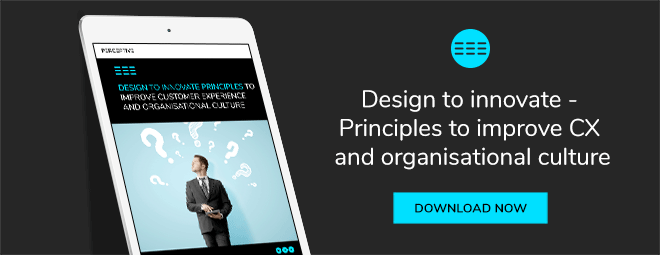 In today’s dynamic market, nailing the customer experience is what businesses need to deliver unique value propositions that differentiate themselves from the competition. Tools, such as NPS and customer feedback surveys, play an invaluable role in managing these relationships, but what if you’ve hit a plateau in your efforts?
In today’s dynamic market, nailing the customer experience is what businesses need to deliver unique value propositions that differentiate themselves from the competition. Tools, such as NPS and customer feedback surveys, play an invaluable role in managing these relationships, but what if you’ve hit a plateau in your efforts?
Many business objectives relate back to providing your customer with a great experience.
For example, Apple’s aim is not to design the best looking product, but to deliver the best mobile experience. Using design thinking can help businesses innovate the customer experience, regardless of your industry. The key is to correctly define the problem, then implement the principles and methodology of design thinking to deliver tangible outcomes.
How does the customer benefit from design thinking?
The reason why DT is so relevant to the customer experience is that it focuses on the customer’s needs above all else. The very first step of the DT process is to uncover real customer needs, which often remain un-expressed by consumers and, therefore, unrealised.
As Steve Jobs once said: "You’ve got to start with the customer experience and work back toward the technology—not the other way around."
DT is unique in that it encourages individuals to fearlessly propose innovative solutions to known problems. Issues are explored from all different angles, without judgement, or fear of failure.
The principles provide the framework for you to test your solutions with small, risk-free experiments which focus on customer empathy, thinking broad and failing fast. The methodology fosters a certain type of creativity and, as a concept itself, it is constantly evolving.
Make the right customer experience changes
When using design thinking, we recommend marrying the approach with customer journey mapping. This will allow you to get real, authentic customer feedback through your research.
Ideally, you’d fuse the insights from your brainstorming with real customer data and analytics to inform and validate your strategies. This approach ensures you make the right customer experience changes and implement those changes the right way. Moreover, you can also measure the performance of your new strategy(ies) to gauge the impact they’ve had.
How might it work?
Here’s an example of how a business might implement design thinking to solve a problem:
Penny is the CEO of ABCBusiness, an accounting software company with a customer retention problem. Lately, she’s found that she’s targeting smaller and smaller customer segments in an attempt to provide a more tailored customer experience to each of them. However, this has not helped to reduce customer churn.
From her customer research, she knows that her main customer segment are first-time small business owners, who are looking for an inexpensive, yet intuitive, bookkeeping system. Feedback from her NPS customer surveys has found her clients are frustrated with her software’s lack of cash flow tracking.
Penny calls an interdisciplinary team together to accurately define the problem. She asks again and again why cash flow tracking is so difficult for their clients, and they drill down to the real issue. Her clients have no visibility on the status of their invoices. They do not know whether they’ve been sent, paid, or are overdue.
Together Penny and her team brainstorm ideas for an invoice tracker. One of her team suggests incorporating a visual scale into their software dashboard to show monies paid versus monies owed. Someone else recommends creating a feature that balances outgoing and incoming monies and compares a business’s estimated cash flow to its actual cash flow each month.
Penny and her team decide to incorporate the second idea into their current software dashboard, knowing that it will suit most small-business needs. However, they also decide to put a more intensive invoice tracking app as a downloadable extension for the ABCBusiness software. This will appeal to clients whose businesses are expanding and require greater visibility over their cash flow to maintain their growth.
Her team create a prototype for each solution and test it on small groups of their customers. They uncover several faults along the way and redevelop each prototype a number of times until it is deemed ready to go live to their full customer base.
The new features are well received and in resolving a core complaint with her software, Penny sees her customer churn drop and customer satisfaction rise.
Want to know more? Download our free eBook and learn how design thinking can improve the customer experience and organisational culture in your business.
